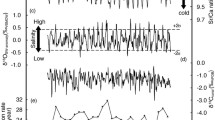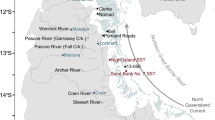Abstract
In order to assess the ability of Porites corals to accurately record environmental variations, high-resolution (weekly/biweekly) coral δ18O records were obtained from four coral colonies from the northern Gulf of Aqaba, which grew at depths of 7, 19, 29, and 42 m along one transect. Adjacent to each colony, hourly temperatures, biweekly salinities, and monthly δ18O of seawater were continuously recorded over a period of 14 months (April 1999 to June 2000). Contrary to water temperature, which shows a regular and strong seasonal variation and change with depth, seawater δ18O exhibits a weak seasonality and little change with depth. Positive correlations between seawater δ18O and salinity were observed. The two parameters were related to each other by the equation δ18O Seawater (‰, VSMOW) = 0.281 × Salinity − 9.14. The high-resolution coral δ18O records from this study show a regular pattern of seasonality and are able to capture fine details of the weekly average temperature records. They resolve more than 95% of the weekly average temperature range. On the other hand, attenuation and amplification of coral seasonal amplitudes were recorded in deep, slow-growing corals, which were not related to environmental effects (temperature and/or seawater δ18O) or sampling resolution. We propose that these result from a combined effect of subannual variations in extension rate and variable rates of spine thickening of skeletal structures within the tissue layer. However, no smoothing or distortion of the isotopic signals was observed due to calcification within the tissue layer in shallow-water, fast-growing corals. The calculations from coral δ18O calibrations against the in situ measurements show that temperature (T) is related to coral δ18O (δ c ) and seawater δ18O (δ w ) by the equation T (°C) = −5.38 (δ c − δ w ) −1.08. Our results demonstrate that coral δ18O from the northern Gulf of Aqaba is a reliable recorder of temperature variations, and that there is a minor contribution of seawater δ18O to this proxy, which could be ignored.










Similar content being viewed by others
References
Aharon P (1991) Recorders of reef environment histories: stable isotopes in corals, giant clams and calcareous algae. Coral Reefs 10:71–90
Alibert C, McCulloch MT (1997) Strontium/calcium ratios in modern Porites corals from the Great Barrier Reef as a proxy for sea surface temperature: calibration of the thermometer and monitoring of ENSO. Paleoceanography 12(3):345–363
Allison NT, Tudhope AW, Fallick AE (1996) Factors influencing the stable carbon and oxygen isotopic composition of Porites lutea coral skeletons from Phuket, south Thailand. Coral Reefs 15:43–57
Al-Rousan S, Al-Moghrabi S, Pätzold J, Wefer G (2002) Environmental and biological effects on the stable oxygen records of corals in the northern Gulf of Aqaba, Red Sea. Mar Ecol Prog Ser 239:301–310
Andrié C, Merlivat L (1989) Contribution des données isotopique de deutérium, oxygène-18, hélium-3 et tritium, à l’étude de la circulation de la Mer Rouge. Oceanol Acta 12:165–174
Barnes DJ, Lough JM (1992) Systematic variations in the depth of skeleton occupied by coral tissue in massive colonies of Porites from the Great Barrier Reef. J Exp Mar Bio Ecol 159:113–128
Barnes DJ, Taylor RB, Lough JM (1995) On the inclusion of trace materials into massive coral skeletons. Part II: distortions in skeletal records of annual climate cycles due to growth processes. J Exp Mar Bio Ecol 194:251–275
Carriquiry JC (1994) 18O fractionation in the coralline aragonite of Porites lobata: implications in oceanic paleothermometry studies. Ciencias Mar 20:585–606
Charles CD, Hunter DE, Fairbanks RG (1997) Interaction between the ENSO and the Asian Monsoon in a coral record of tropical climate. Science 277:925–928
Cohen AL, Hart SR (1997) The effect of colony topography on climate signals in coral skeleton. Geochim Cosmochim Acta 61:3905–3912
Craig H (1961) Standard for reporting concentrations of deuterium and oxygen-18 in natural waters. Science 133:1833–1834
Craig H (1966) Isotopic composition and origin of the Red Sea and Salton Sea geothermal brines. Science 154:1544–1548
Delaygue G, Bard E, Rollion C, Jouzel J, Stievenard M, Duplessy JC, Ganssen G (2001) Oxygen isotope/salinity relationship in the northern Indian Ocean. J Geophys Res 106:4565–4574
de Villiers S, Nelson BK, Chivas AR (1995) Biological controls on coral Sr/Ca and δ18O reconstructions of sea surface temperatures. Science 269:1247–1249
Epstein S, Mayeda TK (1953) Variations of 18O/16O ratio in natural waters. Geochim Cosmochim Acta 4:213–224
Epstein S, Buchsbaum R, Lowenstam HA, Urey HC (1953) Revised carbonate-water isotopic temperature scale. Geol Soc Am Bull 64:1315–1322
Fairbanks RG, Dodge RE (1979) Annual periodicity of the 18 O/16 O and 13 C/12 C ratios in the coral Montastrea annularis. Geochim Cosmochim Acta 43:1009–1020
Felis T, Pätzold J, Loya Y, Wefer G (1998) Vertical water mass mixing and plankton blooms recorded in skeletal stable carbon isotopes of a Red Sea coral. J Geophys Res 103:30731–30739
Felis T, Pätzold J, Loya Y, Moaz F, Nawar AH, Wefer G (2000) A coral oxygen isotope record from the northern Red Sea documenting NAO, ENSO, and North Pacific teleconnection on Middle East climate variability since the year 1750. Paleoceanography 15:679–694
Gagan MK, Chivas AR, Isdale PJ (1994) High-resolution isotopic records from corals using ocean temperature and mass-spawning chronometers. Earth Planet Sci Lett 121:549–558
Gagan MK, Ayliffe LK, Beck JW, Cole JE, Druffel ER, Dunbar RB, Schrag DB (2000) New views of tropical paleoclimates from corals. Quat Sci Rev 19:45–64
Ganssen G, Kroon D (1991) Evidence for Red Sea surface circulation from oxygen isotopes of modern surface waters and planktonic foraminiferal tests. Paleoceanography 6:73–82
Genin A, Lazar B, Brenner S (1995) Vertical mixing and coral death in the Red Sea following the eruption of Mount Pinatubo. Nature 377:507–510
Grossman EL, Ku TL (1986) Oxygen and carbon isotope fractionation in biogenic aragonite: temperature effects. Chem Geol 59:59–74
Heiss GA (1996) Annual band width variation in Porites sp. from Aqaba, Gulf of Aqaba, Red Sea. Bull Mar Sci 59:393–403
Heiss GA, Dullo WC, Joachimski M, Reijmer J, Schuhmacher H (1999) Increased seasonality in the Gulf of Aqaba, Red Sea recorded in the oxygen isotope record of a Porites lutea coral. Senckenb Marit 30:17–26
Hulings NC (1989) A review of marine science research in the Gulf of Aqaba. Amman, Jordan
Hut G (1987) Stable isotope reference samples for geochemical and hydrological investigations. In: Report to the Director General. IAEA, Vienna
Klein R, Pätzold J, Wefer G, Loya Y (1992) Seasonal variations in the stable isotopic composition and the skeletal density pattern of the coral Porites lobata (Gulf of Eilat, Red Sea). Mar Biol 112:259–263
Klein R, Pätzold J, Wefer G, Loya Y (1993) Depth-related timing of density band formation in Porites spp. corals from the Red Sea inferred from x-ray chronology and stable isotope composition. Mar Ecol Prog Ser 97:99–104
Klein R, Tudhope AW, Chilcott CP, Pätzold J, Abdulkarim Z, Fine M, Fallick AE, Loya Y (1997) Evaluating southern Red Sea corals as a proxy record from the Asian monsoon. Earth Plan Sci Lett 148:381–394
Klein RT, Lohmann KC, Thayer CW (1996) Bivalve skeletons record sea-surface temperature and δ18O via Mg/Ca and 18O/16O ratios. Geology 24:415–418
Knutson DW, Buddemeier RW, Smith SV (1972) Coral chronometers: seasonal growth bands in reef corals. Science 177:270–272
Kuhnert H, Pätzold J, Wyrwoll KH (2000) Monitoring climate variability over the past 116 years in coral oxygen isotope from Ningaloo Reef, Western Australia. Int J Earth Sci 88:725–732
Land LS, Lang JC, Barnes DJ (1975) Extension rate: a primary control on the isotopic composition from West Indian (Jamaican) scleractinian coral skeleton. Mar Biol 33:221–233
Leder JJ, Swart PK, Szmant AM, Dodge RE (1996) The origin of variations in the isotopic record of scleractinian corals: I. Oxygen. Geochim Cosmochim Acta 60:2857–2870
Levanon-Spanier I, Padan E, Reiss Z (1979) Primary production in a desert-enclosed sea the Gulf of Aqaba, Red Sea. Deep-Sea Res 26:673–685
Linsely BK, Dunbar RB, Wellington GM, Mucciarone DA (1994) A coral-based reconstruction of Intertropical Convergence Zone variability over Central America since 1707. J Geophys Res 99:9977–9994
Manasreh R (2002) The general circulation and water masses characteristics in the Gulf of Aqaba and northern Red Sea. No 50. Meereswissenschaftliche Berichte Institut für Ostsee Forschung Warnemünde, Universität Rostock
McConnaughey T (1989) 13C and 18O disequilibrium in biological carbonates: I. Patterns. Geochim Cosmochim Acta 53:163–171
Morimoto M, Kayanne H, Yonekura N, Abe O, Matsumoto E (1998) Effect of seasonal difference in growth rate of coral skeletons on oxygen isotope records. In: Matsumoto E (ed) Coral climatology by annual bands. Proc 3rd Int Marine Science Symp, Japan, Marine Science Foundation, Tokyo, pp 30–34
Moustafa YA, Pätzold J, Loya Y, Wefer G (2000) Mid-Holocene stable isotope record of corals from the northern Red Sea. Int J Earth Sci 88:742–751
Paillard D, Labeyrie L, Yiou P (1996) Macintosh Program Performs time-series analysis. EOS Trans Am Geophys Un 77(39):379
Pätzold J (1984) Growth rhythms recorded in stable isotope and density bands in reef coral Porites lobata (Cebu, Philippines). Coral Reefs 3:87–90
Pätzold J (1986) Temperature and CO2 changes in tropical surface waters of the Philippines during the past 120 years: record in the stable isotopes of hermatypic corals. No 12. Berichte, Geologisches Paläontologisches Institut Universität Kiel, Germany
Quinn TM, Taylor FW, Crowley TJ, Link SM (1996) Evaluation of sampling resolution in coral stable isotope records: a case study using records from New Caledonia and Tarawa. Paleoceanography 11:529–542
Quinn TM, Crowely TJ, Taylor FW, Henin C, Joannot P, Join Y (1998) A multicentury stable isotope record from a New Caledonia coral: interannual and decadal sea surface temperature variability in the southwest Pacific since1657 a.d. Paleoceanography 13:412–426
Reiss Z, Hottinger L (1984) The Gulf of Aqaba: ecological micropaleontology. Springer, Berlin Heidelberg New York
Suzuki A, Yukino I, Kawahata H (1999) Temperature–skeletal δ18O relationship of Porites australiensis from Ishigaki Island, the Ryukyus, Japan. Geochem J 33:419–428
Swart PK (1983) Carbon and oxygen isotope fractionation in scleractinian corals: a review. Earth-Sci Rev 19:51–80
Taylor RB, Barnes DJ, Lough JM (1995) On the inclusion of trace materials into massive coral skeletons, I. Material occurring in the environment in short pulses. J Exp Mar Bio Ecol 85:255–278
Wefer G, Berger WH (1991) Isotope paleontology: growth and composition of extant calcareous species. Mar Geol 100:207–248
Wellington GM, Dunbar RB, Merlen G (1996) Calibration of stable oxygen isotope signatures in Galápagos corals. Paleoceanography 11:467–480
Acknowledgements
This study was carried out as part of the first author’s PhD thesis at Bremen University. We are grateful to the Marine Science Station divers staff in Aqaba for their assistance with fieldwork and water sample collection. Special thanks are also due to R. Manasreh for providing salinity records from Aqaba. T. Felis and H. Kuhnert are deeply thanked for their constructive comments on the manuscript. The manuscript was significantly improved by the efforts of Peter Swart and an anonymous reviewer. All isotopic measurements were carried out at Bremen University. We are grateful to M. Segl for stable isotope analysis. This work is part of the Red Sea Program (RSP, II), funded by the German Federal Ministry of Education, Science, Research, and Technology (BMBF).
Author information
Authors and Affiliations
Corresponding author
Rights and permissions
About this article
Cite this article
Al-Rousan, S., Al-Moghrabi, S., Pätzold, J. et al. Stable oxygen isotopes in Porites corals monitor weekly temperature variations in the northern Gulf of Aqaba, Red Sea. Coral Reefs 22, 346–356 (2003). https://doi.org/10.1007/s00338-003-0321-6
Received:
Accepted:
Published:
Issue Date:
DOI: https://doi.org/10.1007/s00338-003-0321-6




